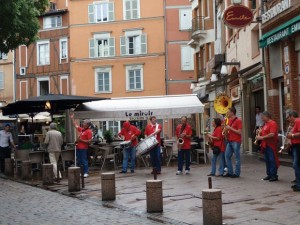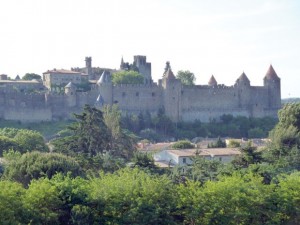

Gerald and Jean Hasser booked their May 2012 Canal du Midi bike tour with BikeTours.com (formerly BikeToursDirect) and published this trip report, “Biking in the South of France,” in the Napa Valley Register.
A nine-day trip through the Languedoc region in the south of France is scenic, historic, gastronomic, mostly level, feasible for bike riders of various ages and abilities — and it’s affordable.

After playing tourist in Paris and Avignon for a week, we arrived via train in late May at the starting point for the bicycle trip in the city of Seté on the Mediterranean coast. One can fly from San Francisco and eventually end up at the nearest airport in Montpelier, but why skip Paris and other interesting places on the way?
Days and nights of walking and standing in museums, monuments and galleries left our feet looking forward to pushing nothing harder than bicycle pedals.
Seté is a working port city. Our first lodging overlooked the recreational harbor, providing a nice sunset. Our room at the (not too) Grand Hotel provided a good night’s sleep following a delicious dinner in the ground floor restaurant.
Monday morning after breakfast, we met the pleasant young man representing francebike.com, as well as several new German friends who had booked the same route. This trip was self-guided so we did not ride together; however, we often met up with each other at meals and points along the way. Fortunately, our new friends were trilingual and rescued us more than once from restaurant miscues.

Once equipped with excellent new mountain bikes with waterproof saddlebags, bump-absorbing suspensions, and seats, we were on our way in the warm sun. Our previous European bike journeys had been mostly on smoothly paved paths and roads. This trip was different, much of it on dirt paths alongside the canal, with tree roots and other jolts aplenty. The suspensions and large tires were a great help in easing the bumps. Also helpful was the most important garment of any bike trip: fully padded bike shorts.
Our representatives had given us maps and directions and assured us there were plenty of little red directional arrows along the way to keep us from getting lost. It didn’t take us long to disprove that. One might call that part of the fun — or not. We sometimes went for miles without spotting the promised little red arrows, but still managed to arrive at our destination each night. The next step could be GPS units on the bikes to reduce marital navigation arguments and excessive U-turns.
Leaving Seté, we progressed along a paved beach path for several miles before turning inland to Agde, then passing through vineyards and fields of lavender and red poppies to Cap d’Agde, a Mediterranean resort town with a Coney Island feel. After a frigid dip in the unheated pool and a memorably bad pizza, we turned in at our motel around the corner from the dinosaur-themed amusement park. We realized we were lucky to pass through before the hordes of summer arrived.
The tour operator keeps travelers’ costs down by mostly booking modest two-star lodgings. Most of these were acceptable, providing clean private baths, good beds, and reasonably quiet surroundings. The exception was the Hotel du France in the hill town of Bezier, our next stop. The air conditioning did not exist; large chunks of plaster were missing from the walls; the shower doors leaky enough to create a lake on the floor; and the spirit of Irma la Douce was present, though sometimes disturbed by the drunks yelling in the street below. Ambiance — could that be a French word? The clerk was a great guy who seemed embarrassed to work there.
Conversely, the tour operator is clearly a gourmand, choosing excellent dinner restaurants at the towns along the way.
Bezier, like so many towns in this part of the world, has a striking cathedral at its most prominent point, overlooking the countryside. From here we could see the canal passing over the river, near a staircase of eight locks just outside town.
The Canal du Midi, a UNESCO historic site, is a 150-mile-long engineering marvel of the 17th century, which took several decades and many thousands of people to build. It created a shipping route connecting the Atlantic Ocean to the Mediterranean Sea, allowing commerce to flow without the many risks of shipping around the Strait of Gibraltar. The canal includes 91 locks and numerous bridges, including aqueducts over rivers and creeks. It is still in working condition, now used mostly by tourist vessels that are privately or commercially operated. Many of the boats barely squeeze through the bridges and locks, gliding at a stately pace comparable to us on bikes, with champagne-sipping sunbathers atop.
The beauty and comfort of the canal is enhanced by thousands of large plane trees providing comforting shade and perches to many singing birds. Sadly, they are dying from a wilt infection and are projected to need replacing within the next 20 years.
The tree roots bumped us along much of the way the next hot and windy day through open and abundant farm fields past horses grazing in standing water marshes to Narbonne, a pleasant town with a plaza full of children playing next to the cathedral, complete with a portion of ancient Roman road as a centerpiece.
The following day took us to the lovely village of Homps, with a stop for lunch at another village where we encountered our first and only snooty waiter of the trip. It was France, after all; and the trip would not have been complete without one. Our canal-side dinner in Homps at En Bonne Compagnie more than made up for that, with great and friendly service, and food so good and gorgeous that people photographed it before dining.

The route from Homps led to Carcassonne with its spectacular restored medieval fortress old city, with views to the snow-capped Pyrenees. Carcassonne was a critical location during the Crusades of the Middle Ages and changed hands more than once. The fortress was restored over several decades in the 19th century and is now a stunning UNESCO world heritage site, eminently suitable for beers at an outdoor café after a long ride and tour of the fortress, complete with browsing the many shops inside the walls. Our room at the three-star Les Trois Couronnes looked out at the warmly lit fortress under a bright full moon to lull us into the sleep of babes.
An uneventful next leg found us in the small town of Castelnaudery, where the largest of the tour boat operations is based. Some amusement is provided watching the renters of yachts fumbling their way through their orientation in the canal’s large turning basin before signing on the dotted line. Our bike orientation was much less stressful by comparison.
The final day of riding was scotched by steady rain. No worries, we simply took the local train to Toulouse, warm and dry and comfortable with our bikes hanging by hooks in the adjoining car. Our decision to wimp out on the train instead of toughing it out on the bike path was vindicated at each station along the way as we watched dripping bicyclists board the train.
We arrived in Toulouse rested and dry, a block from our final hotel, in time to witness the aftermath of a nearby car versus motorcycle crash with much shouting and fist shaking, but no punches thrown or obvious injuries. It seemed the high point of the day for the many café-lounging witnesses.
Toulouse is lovely, with many wrought-iron balconies such as inspired the style many associate with New Orleans; a lively street scene, many fine restaurants, a huge main plaza used regularly for festivals and impressive museums.
See our Canal du Midi tours >
Read the original article >
Featured destinations, Self-guided, France